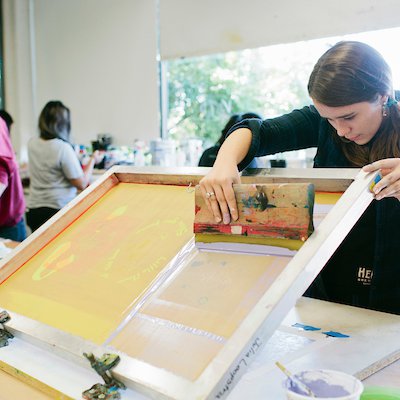The Necessary Guide to Recognizing Screen Printing and Its Versatile Utilizes
Screen printing has a rich background that dates back to old times, developing right into an advanced technique utilized across numerous industries today. This overview explores the details of the screen printing process, describing its applications in fashion, advertising, and home design - 10:9 Design Embroidery. Comprehending these principles can open up innovative possibility for both commercial and creative jobs. The adhering to areas will expose crucial tips and methods to boost one's screen printing undertakings
The History of Screen Printing
Screen printing has origins that map back centuries, its advancement reflects the creative and technological improvements of numerous societies. Coming from old China, the strategy was originally made use of for decorating textiles and later spread to Japan, where it became essential to Ukiyo-e woodblock printing. The method moved to Europe in the 18th century, where it obtained appeal amongst craftsmens and commercial printers. The innovation of picture emulsion in the 20th century transformed screen printing, permitting more elaborate styles and greater efficiency. Artists like Andy Warhol better pushed its appeal, utilizing the medium to create legendary jobs that mixed commercialism and art. By the late 20th century, screen printing had developed itself as a functional method, utilized in fashion, advertising, and great art. Today, it proceeds to progress, integrating digital modern technology and broadening its applications across various sectors.
The Screen Printing Refine Explained
Screen printing transforms imaginative visions right into concrete designs via a series of precise actions. Originally, a picture is created and after that transferred onto a screen, generally made of great mesh material extended over a framework. A light-sensitive emulsion is put on the screen, which is subjected to light, solidifying in areas not covered by the photo. After washing out the unhardened emulsion, a pattern is formed.
Next off, the screen is put over the substrate, whether it be textile, paper, or one more product. Ink is after that pushed via the open areas of the pattern utilizing a squeegee, depositing the style onto the substrate listed below. This process can be duplicated for multiple shades, requiring different displays for every tone. The printed product is healed utilizing warm to ensure the ink adheres properly, resulting in a resilient, dynamic style ready for use.
Kinds Of Screen Printing Techniques

Furthermore, specialty strategies, such as discharge screen printing, remove color from the material to develop softer prints, while foil screen printing uses metallic aluminum foil to achieve a glossy finish (10:9 Design contact). Each strategy offers unique characteristics, satisfying numerous creative demands and production scales, ultimately increasing the possibilities within the screen printing domain name
Applications of Screen Printing in Various Industries

In addition, the signage and marketing fields utilize screen printing for producing attractive display screens and banners. This method enables for strong shades and complex styles that catch focus. In electronics, screen printing is utilized for applying conductive inks to circuit card, important for element connections. Moreover, the home decoration industry welcomes screen printing to produce unique styles on fabrics and wall art. Overall, screen printing serves as an important device throughout varied areas, boosting items with individualized and aesthetically enticing graphics.
Tips for Effective Screen Printing Projects
While taking on a screen printing task, mindful focus to information can substantially boost the last end result. Choosing top notch materials is vital; this includes the screen, inks, and substrates. Using appropriate mesh matters can influence ink deposition and information resolution. Prep work is similarly essential; extensive cleaning of screens and proper exposure times guarantee crisp prints.
Next off, precise registration is vital for multi-color prints. Using check my reference alignment tools can aid attain exact layering. Furthermore, testing prints on scrap materials before manufacturing assists determine possible problems without squandering resources.

Often Asked Inquiries
What Products Are Finest for Screen Printing on Textile?
Cotton and polyester blends are perfect for screen printing on material because of their longevity and ink absorption. Additionally, specialty textiles like silk or canvas can create special structures and surfaces, improving the overall design quality.
How Do I Tidy and Maintain Screen Printing Devices?
To preserve and clean screen printing equipment, one should routinely wash screens with ideal solvents, evaluate mops for wear, lube moving components, and store all items in a completely dry, dust-free setting to extend their lifespan.
What Are the Ecological Influences of Screen Printing?
Screen printing can have considerable environmental influences, consisting of chemical waste from inks and solvents, water usage throughout cleaning procedures, and power consumption. Lasting methods and environment-friendly materials are important for minimizing these adverse effects.
Can Screen Printing Be Done in the house Successfully?
Screen printing can be effectively done at home with the ideal materials and methods. Hobbyists can produce quality prints, though success relies on their skill degree, equipment, and understanding of the procedure involved.
What Are the Prices Connected With Beginning a Display Printing Company?

Beginning a screen printing organization involves expenses for devices, products, and workspace. Preliminary costs commonly range from a few hundred to numerous thousand dollars, depending upon the range, top quality of equipment, and desired production ability.
Screen printing has a rich history that dates back to ancient times, Discover More progressing right into an innovative strategy made use of throughout numerous sectors today. An additional technique, rotating screen printing, employs cylindrical displays, facilitating continuous printing on fabric rolls, thus enhancing efficiency for large-scale productions. Additionally, specialty strategies, such as discharge screen printing, get rid of color from the textile to produce softer prints, while aluminum foil screen printing applies metallic aluminum foil to attain a glossy surface. In the fashion industry, screen printing is widely used to vinyl signs and banners develop vivid layouts on clothing, allowing brands to display their one-of-a-kind designs. Cotton and polyester blends are optimal for screen printing on material due to their sturdiness and ink absorption.